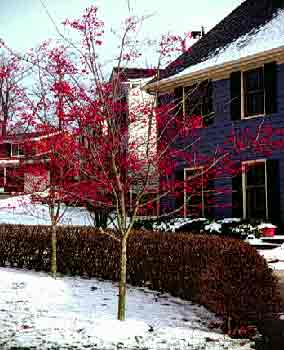 Green Hawthorn - Crataegus viridis
Green Hawthorn - Crataegus viridis
Rose Family (Rosaceae)
- Native habitat: Eastern North America south of Pennsylvania, west to Texas and Iowa.
- Growth habit: Tree shape is a rounded, symmetrical, upright form.
- Tree size: This tree grows to an average height of 20 to 30 feet with a similar spread. It has a moderate growth rate and a moderate to long life span.
- Flower and fruit: Flowers are 3/4-inch in diameter with five white petals and grow in 2-inch clusters. The fruit is less than half an inch in diameter, round, fleshy, abundant, orange to red and persists in winter.
 Leaf: This tree has dark green foliage in summer that changes to red to gold in fall. Leaves are simple, alternate and 1 to 2 inches long.
Leaf: This tree has dark green foliage in summer that changes to red to gold in fall. Leaves are simple, alternate and 1 to 2 inches long.- Hardiness: Winter hardy to USDA Zone 4.
'Winter King' is an excellent landscape plant and is used in place of the species. It is superior in flower and fruit production.Winter King hawthorn is very dense, thus it is well-suited for use as a hedge. The ‘Winter King' cultivar was introduced in 1955. The cultivar is usually grafted onto Washington hawthorn rootstock.
There are numerous hawthorn species available in the nursery trade. The most common species include C. crus-galli, C. x lavallei, and C. phaenopyrum.
 Green hawthorn (Crataegus viridis) was discovered by John Clayton, clerk of the court in Gloucester, Va., near Norfolk in the 18th century. Clayton sent the tree to Linnaeus for identification. Linnaeus included it as one of three North American hawthorns in his Species Plantarum in 1753.
Green hawthorn (Crataegus viridis) was discovered by John Clayton, clerk of the court in Gloucester, Va., near Norfolk in the 18th century. Clayton sent the tree to Linnaeus for identification. Linnaeus included it as one of three North American hawthorns in his Species Plantarum in 1753.



